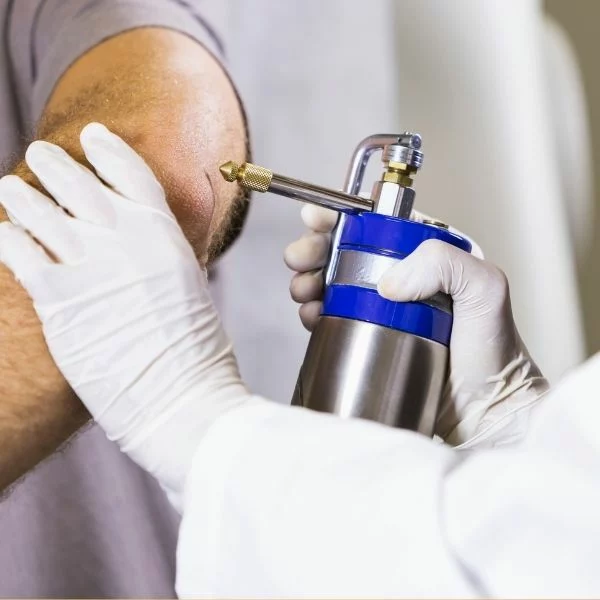
At my clinic in Limerick, I offer Cryotherapy, a cutting-edge treatment that uses extreme cold to safely and effectively remove abnormal tissue. This method is especially beneficial for treating skin tags, age spots, and actinic keratosis. It’s a quick, minimally invasive procedure ideal for those seeking a non-surgical solution for skin imperfections.
Cryotherapy involves the application of liquid nitrogen to the targeted skin lesions. This extreme cold causes the abnormal cells to freeze and die, after which they naturally fall off. The surrounding healthy skin is preserved, making this a precise and effective treatment for specific skin issues.
During our consultation, I’ll examine your skin and discuss your treatment goals. I will assess the areas you’re concerned about and recommend a customised treatment plan. Your safety and suitability for Cryotherapy will be thoroughly evaluated, including any potential contraindications.
In your initial consultation at my clinic, I will assess the skin lesions and discuss the expected outcomes. Understanding your medical history and any previous skin treatments is crucial for a safe and effective procedure.
Generally, Cryotherapy does not require anesthesia due to its quick and minimally invasive nature. Most clients report only a mild, cold sensation during the procedure.
The Cryotherapy procedure is quick, typically taking just a few minutes. I apply liquid nitrogen to the targeted area using a precise application method to minimise discomfort and maximise effectiveness.
After the treatment, the treated area may show redness or form a small blister, which is a normal part of the healing process. The lesion will gradually dry up and fall off. I'll provide detailed aftercare instructions to ensure proper healing and optimal results.


For Cryotherapy
Your Most Common Queries:
Here’s What I’m Often Asked About Cryotherapy for Skin Tags, Age Spots, and Actinic Keratosis
In my clinic, the cryotherapy treatment for skin tag removal involves applying liquid nitrogen to the skin tag using a precise applicator. The extreme cold freezes the skin tag, causing it to eventually fall off. The procedure is quick, typically lasting only a few minutes, and is performed with utmost care to ensure comfort and effectiveness.
Common side effects include temporary redness, blistering, or slight scarring at the treatment site. These usually resolve on their own. I provide detailed aftercare instructions to minimize any side effects and promote healing.
No, cryotherapy is a non-invasive treatment with minimal downtime. You can resume your normal activities immediately after the procedure.
I advise avoiding strenuous activities and direct sun exposure immediately after treatment. Also, it’s important not to pick at the treated area and allow it to heal naturally. I’ll provide you with a tailored aftercare regime during your visit.
Healing time varies, but typically it takes about one to two weeks for the skin to heal completely after liquid nitrogen treatment.
Absolutely. Cryotherapy is effective in reducing the appearance of age spots by freezing the pigmented cells, which then peel off over time.
Age spots, also known as liver spots or solar lentigines, are the result of an excess production of melanin, the pigment that gives skin its color. Prolonged and cumulative exposure to UV rays from the sun or artificial sources like tanning beds is the primary cause. These spots are a protective response from the skin to shield deeper layers from UV damage. They are more common in individuals over 50 but can occur in younger people who spend a lot of time in the sun. Factors such as skin type, genetics, and lifestyle also play a role in their development.
Yes, cryotherapy treatments can be repeated if necessary. During follow-up consultations, I assess the skin’s response to the initial treatment and determine if further sessions are required. The frequency and number of repeat treatments depend on the individual’s skin type, the severity of the lesions, and their response to the initial cryotherapy session.